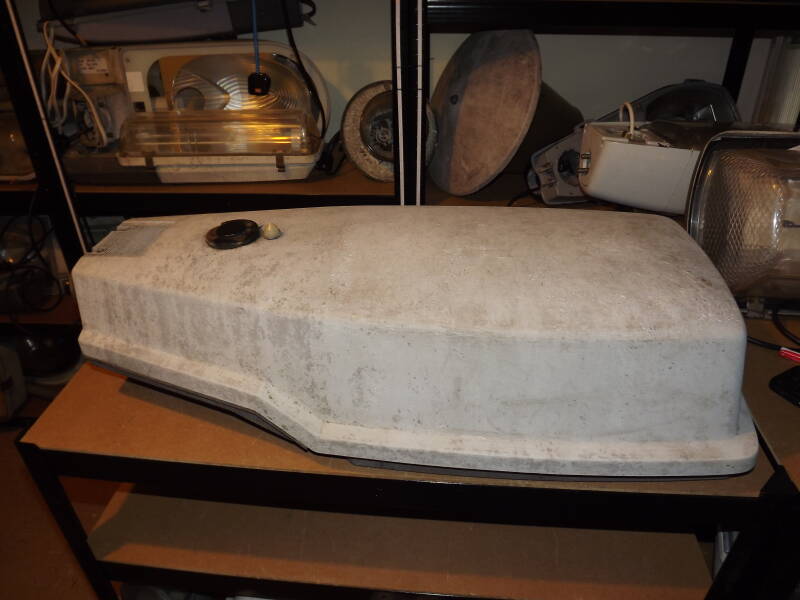My Collection: Philips SGS204
| Manufacturer | Philips |
| Catalogue Number (model) | SGS204/250TG |
| Wattage | 400W |
| Lamp-Type | SON-T & MH |
| Gear | None (currently in the post on it's way) |
| Ballast | - |
| Ignitor | - |
| Capacitor | - |
| Photocell | Zodion SS55 two-part detector & plugged NEMA socket |
| IP Rating (when new) | IP43 |
| Date Of Manufacture | July 1992 |
| Date on Lamp | NOS |
| Date Acquired | 11/02/2025 |
| Restoration Status | Cleaned |
| Collection Number | #146 |
This enormous lantern was removed in 2010 from the London area (possibly the M25 but that is just speculation). It came with a 400W lamp and gear, but was originally a 250W lantern. Whether it was changed to a 400W lantern during it's service or after it's removal remains unclear. Being 400W it is my most powerful high-pressure sodium lantern.
A better sense of scale is given when viewing the SGS203 next to the SGS204. Considering the SGS203 isn't a small lantern itself, the SGS204 is a monster! It measures ~81cm long.
A view from below provides a more-familiar perspective of the lantern:
On top of the lantern is quite an unusual sight: a Zodion SS55 two-part CdSi detector, yet right next to it is a plugged NEMA socket. Why the NEMA socket wasn't used isn't clear, instead a hole was drilled for the two-part cell.
At the rear of the lantern is the spigot, which incidentally is also used by the SGS201 and SGS203, but not the SGS202. Also notice the heat sink for the ballast, to prevent the fixture from overheating.
Two screws fasten the spigot into the lantern, it can also be flipped for 42mm-48mm post-top mounting.
Much like the SGS203, a clip is located at the front of the lantern, but unlike the SGS203 this is not to access the gear.
This clip is only there to open the lamp-compartment. This confused me and I was wondering how on earth I was meant to access the gear-area.
The lantern is fitted with a brand-new and never lit 400W HQI-T lamp.
I did eventually figure out how the lantern was supposed to open. In yet more trickery from the SGS204, the screws I originally thought were something to do with the spigot or hinges actually turned out to keep the canopy locked. Given they go through the canopy which I believed would hinge much like the SGS203, I'm not sure what I was expecting.
In an incredibly unique motion, the canopy and bowl hinge towards the front of the lantern, with the actual hinges being situated in the centre. This did not make it easy to work on, as the spring inside was quite stiff and it needed some wrestling to get it to stay open wide enough for me to remove the gear-area.
The ballast was fried and thus removed, evidently the lantern suffered some water-intake problems during service, and a huge black mark indicated the capacitor may have exploded. The original ignitor remains in the lantern, as upon opening it, it looked intact, but it's unknown if it works.


















